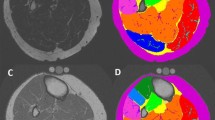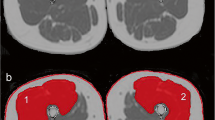Abstract
Background
In individuals with knee osteoarthritis (OA), fatty infiltration into thigh muscle is associated with poor physical performance and strength. However, it is not known whether this also occurs in the calf and if this impacts physical function.
Aims
We investigated the relationships between volumes of intramuscular fat (intraMF), intermuscular fat (IMF), subcutaneous fat (SCF), lean muscle and muscle adiposity, in the thighs compared to the calves of women with knee OA.
Methods
MRI scans of the thigh and calf were acquired from 20 women over 55 years with knee OA (3.0T Discovery MR750, GE Healthcare). Axial IDEAL (iterative decomposition of water and fat with echo asymmetry and least-squares estimation) fat-separated images were segmented to quantify intraMF, IMF, SCF and lean muscle volumes (SliceOmatic 5.0, Tomovision). Correlation and linear regression analyses were run.
Results
We found a positive relationship between thigh and calf intraMF (R 2 = 0.592; B = 5.49; p = 0.001), muscle adiposity (R 2 = 0.539; B = 0.567; p = 0.001), and SCF volume (R 2 = 0.699; B = 12.847; p = 0.001), controlling for waist-to-hip ratio. Relationships between thigh and calf IMF (R 2 = 0.239; B = 7.743; p = 0.061), lean muscle (R 2 = 0.245; B = 4.149; p = 0.047) and combined intraMF and IMF volume (R 2 = 0.242; B = 6.162; p = 0.044) were not significant.
Discussion
Although a correlation exists between thigh and calf muscle adiposity, intraMF and SCF, this does not hold true for IMF or lean muscle. A greater amount of intraMF infiltration occurs in the thigh compared to the calf of women with knee OA.
Conclusion
The calf and thigh may both be involved in pathologic changes in muscle composition in knee OA.




Similar content being viewed by others
References
Davis MA, Ettinger WH, Neuhaus JM et al (1991) Knee osteoarthritis and physical functioning: evidence from the NHANES I Epidemiologic Followup Study. J Rheumatol 18:591–598
Gür H, Cakin N (2003) Muscle mass, isokinetic torque, and functional capacity in women with osteoarthritis of the knee. Arch Phys Med Rehabil 84:1534–1541
Kumar D, Karampinos DC, MacLeod TD et al (2014) Quadriceps intramuscular fat fraction rather than muscle size is associated with knee osteoarthritis. Osteoarthr Cartil OARS Osteoarthr Res Soc 22:226–234
Conroy MB, Kwoh CK, Krishnan E et al (2012) Muscle strength, mass, and quality in older men and women with knee osteoarthritis. Arthr Care Res 64:15–21
Maly MR, Calder KM, Macintyre NJ et al (2013) Relationship of intermuscular fat volume in the thigh with knee extensor strength and physical performance in women at risk of or with knee osteoarthritis. Arthr Care Res 65:44–52
Yoshida Y, Marcus RL, Lastayo PC (2012) Intramuscular adipose tissue and central activation in older adults. Muscle Nerve 46:813–816
Goodpaster BH, Carlson CL, Visser M et al (2001) Attenuation of skeletal muscle and strength in the elderly: the Health ABC Study. J Appl Physiol 90:2157–2165
Wluka AE, Lombard CB, Cicuttini FM (2013) Tackling obesity in knee osteoarthritis. Nat Rev Rheumatol 9:225–235
Segal NA, Zimmerman MB, Brubaker M et al (2011) Obesity and knee osteoarthritis are not associated with impaired quadriceps specific strength in adults. PM R 3:314–323 (quiz 323)
Wang X, Miller GD, Messier SP et al (2007) Knee strength maintained despite loss of lean body mass during weight loss in older obese adults with knee osteoarthritis. J Gerontol A Biol Sci Med Sci 62:866–871
Marcus RL, Addison O, Kidde JP et al (2010) Skeletal muscle fat infiltration: impact of age, inactivity, and exercise. J Nutr Health Aging 14:362–366
Addison O, Marcus RL, LaStayo PC et al (2014) Intermuscular fat: a review of the consequences and causes. Int J Endocrinol 2014:e309570
Noble JJ, Charles-Edwards GD, Keevil SF et al (2014) Intramuscular fat in ambulant young adults with bilateral spastic cerebral palsy. BMC Musculoskelet Disord 15:236
Fujiwara N, Nakagawa H, Kudo Y et al (2015) Sarcopenia, intramuscular fat deposition, and visceral adiposity independently predict the outcomes of hepatocellular carcinoma. J Hepatol 63:131–140
Miljkovic I, Kuipers AL, Cauley JA et al (2015) Greater skeletal muscle fat infiltration is associated with higher all-cause and cardiovascular mortality in older men. J Gerontol A Biol Sci Med Sci 70:1133–1140
Lorbergs AL, Noseworthy MD, Adachi JD et al (2015) Fat infiltration in the leg is associated with bone geometry and physical function in healthy older women. Calcif Tissue Int 97:353–363
Tuttle LJ, Sinacore DR, Mueller MJ (2012) Intermuscular adipose tissue is muscle specific and associated with poor functional performance. J Aging Res 2012:e172957
Hubley-Kozey CL, Deluzio KJ, Landry SC et al (2006) Neuromuscular alterations during walking in persons with moderate knee osteoarthritis. J Electromyogr Kinesiol Off J Int Soc Electrophysiol Kinesiol 16:365–378
Brandon SCE, Miller RH, Thelen DG et al (2014) Selective lateral muscle activation in moderate medial knee osteoarthritis subjects does not unload medial knee condyle. J Biomech 47:1409–1415
Childs JD, Sparto PJ, Fitzgerald GK et al (2004) Alterations in lower extremity movement and muscle activation patterns in individuals with knee osteoarthritis. Clin Biomech Bristol Avon 19:44–49
Li L, Landin D, Grodesky J et al (2002) The function of gastrocnemius as a knee flexor at selected knee and ankle angles. J Electromyogr Kinesiol Off J Int Soc Electrophysiol Kinesiol 12:385–390
Altman R, Asch E, Bloch D et al (1986) Development of criteria for the classification and reporting of osteoarthritis. Classification of osteoarthritis of the knee. Diagnostic and Therapeutic Criteria Committee of the American Rheumatism Association. Arthr Rheum 29:1039–1049
Kothari M, Guermazi A, von Ingersleben G et al (2004) Fixed-flexion radiography of the knee provides reproducible joint space width measurements in osteoarthritis. Eur Radiol 14:1568–1573
Costa DN, Pedrosa I, McKenzie C et al (2008) Body MRI using IDEAL. AJR Am J Roentgenol 190:1076–1084
Lee S, Lucas RM, Lansdown DA et al (2015) Magnetic resonance rotator cuff fat fraction and its relationship with tendon tear severity and subject characteristics. J Shoulder Elb Surg Am Shoulder Elb Surg Al. doi:10.1016/j.jse.2015.01.013
Ruhdorfer A, Dannhauer T, Wirth W et al (2013) Thigh muscle cross-sectional areas and strength in advanced versus early painful osteoarthritis: an exploratory between-knee, within-person comparison in osteoarthritis initiative participants. Arthr Care Res 65:1034–1042
Bonekamp S, Ghosh P, Crawford S et al (2008) Quantitative comparison and evaluation of software packages for assessment of abdominal adipose tissue distribution by magnetic resonance imaging. Int J Obes 32:100–111
Beattie KA, MacIntyre NJ, Ramadan K et al (2012) Longitudinal changes in intermuscular fat volume and quadriceps muscle volume in the thighs of women with knee osteoarthritis. Arthr Care Res 64:22–29
Chacko AK, Katzberg RW, MacKay A (1991) MRI atlas of normal anatomy. McGraw-Hill, New York
Demerath EW, Ritter KJ, Couch WA et al (2007) Validity of a new automated software program for visceral adipose tissue estimation. Int J Obes 31:285–291
Roos EM, Toksvig-Larsen S (2003) Knee injury and osteoarthritis outcome score (KOOS)—validation and comparison to the WOMAC in total knee replacement. Health Qual Life Outcomes 1:17
Kessler S, Grammozis A, Gunther KP et al (2011) The intermittent and constant pain score (ICOAP)—a questionnaire to assess pain in patients with gonarthritis. Z Orthop Unfallchir 149:22–26
Tsonga T, Kapetanakis S, Papadopoulos C et al (2011) Evaluation of improvement in quality of life and physical activity after total knee arthroplasty in greek elderly women. Open Orthop J 5:343–347
Wroblewski AP, Amati F, Smiley MA et al (2011) Chronic exercise preserves lean muscle mass in masters athletes. Phys Sports Med 39:172–178
Karampinos DC, Baum T, Nardo L et al (2012) Characterization of the regional distribution of skeletal muscle adipose tissue in type 2 diabetes using chemical shift-based water/fat separation. J Magn Reson Imaging JMRI 35:899–907
David A. Winter (2015) Biomechanics and motor control of human movement, 4th edn. Wiley, New York. http://ca.wiley.com/WileyCDA/WileyTitle/productCd-0470398183.html. Accessed 1 Jun 2015
Ruhdorfer A, Wirth W, Dannhauer T et al (2015) Longitudinal (4 year) change of thigh muscle and adipose tissue distribution in chronically painful vs painless knees—data from the osteoarthritis initiative. Osteoarthr Cartil OARS Osteoarthr Res Soc. doi:10.1016/j.joca.2015.04.004
Messier SP, Beavers DP, Loeser RF et al (2014) Knee joint loading in knee osteoarthritis: influence of abdominal and thigh fat. Med Sci Sports Exerc 46:1677–1683
Acknowledgments
Michael J. Davison’s Master of Science education research was supported by McMaster University Department of Medicine’s Graduate Research Initiative, the Natural Sciences and Engineering Council of Canada (MRM) and the Canadian Foundation for Innovation and the Ontario Ministry of Research and Innovation (MRM).
Author information
Authors and Affiliations
Corresponding author
Ethics declarations
Conflict of interest
The authors declare that they have no conflict of interest.
Ethical approval
All procedures performed in this study involving human participants were in accordance with the ethical standards of the Hamilton Integrated Research Ethics Board and with the 1964 Helsinki declaration and its later amendments.
Informed consent
Informed consent was obtained from all individual participants included in the study.
Rights and permissions
About this article
Cite this article
Davison, M.J., Maly, M.R., Adachi, J.D. et al. Relationships between fatty infiltration in the thigh and calf in women with knee osteoarthritis. Aging Clin Exp Res 29, 291–299 (2017). https://doi.org/10.1007/s40520-016-0556-z
Received:
Accepted:
Published:
Issue Date:
DOI: https://doi.org/10.1007/s40520-016-0556-z




